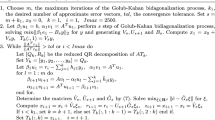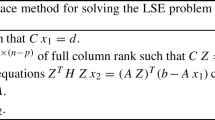Abstract
It is well-known that many Krylov solvers for linear systems, eigenvalue problems, and singular value decomposition problems have very simple and elegant formulas for residual norms. These formulas not only allow us to further understand the methods theoretically but also can be used as cheap stopping criteria without forming approximate solutions and residuals at each step before convergence takes place. LSQR for large sparse linear least squares problems is based on the Lanczos bidiagonalization process and is a Krylov solver. However, there has not yet been an analogously elegant formula for residual norms. This paper derives such kind of formula. In addition, the author gets some other properties of LSQR and its mathematically equivalent CGLS.
Similar content being viewed by others
References
B. N. Parlett, The Symmetric Eigenvalue Problem, SIAM, Philadelphia, 1998.
Y. Saad, Numerical Methods for Large Eigenvalue Problems, Manchester University Press, UK, 1992.
C. C. Paige and M. A. Saunders, Algorithm 583 LSQR: Sparse linear equations and sparse least squares, ACM Trans. Math. Software, 1982, (8): 195–209.
Y. Saad, Iterative Methods for Large Sparse Linear Systems, 2nd Edition, SIAM, Philadelphia, 2003.
G. W. Stewart, Matrix Algorithms Vol. II, Eigensystems, SIAM, Philadelphia, 2001.
Z. Jia and D. Niu, An implicitly restarted bidiagonalization Lanczos method for computing a partial singular value decomposition, SIAM Journal on Matrix Anal, Appl., 2003, (25): 246–265.
J. Baglama and L. Reichel, Augmented implicitly restarted Lanczos bidiagonalization methods, SIAM Journal on Sci. Comput., 2005, 28(1): 19–42.
C. C. Paige and M. A. Saunders, LSQR, an algorithm for sparse linear equations and sparse least squares, ACM Trans, Math. Software, 1982, (8): 43–71.
Björck, Numerical Methods for Least Squares Problems, SIAM, Philadelphia, 1996.
Author information
Authors and Affiliations
Corresponding author
Additional information
This research is supported in part by the National Science Foundation of China under Grant No. 10771116 and the Doctoral Program of the Ministry of Education under Grant No. 20060003003.
Rights and permissions
About this article
Cite this article
Jia, Z. Some properties of LSQR for large sparse linear least squares problems. J Syst Sci Complex 23, 815–821 (2010). https://doi.org/10.1007/s11424-010-7190-1
Received:
Published:
Issue Date:
DOI: https://doi.org/10.1007/s11424-010-7190-1




